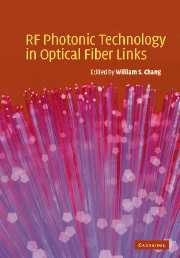Book contents
- Frontmatter
- Contents
- List of contributors
- Introduction and preface
- 1 Figures of merit and performance analysis of photonic microwave links
- 2 RF subcarrier links in local access networks
- 3 Analog modulation of semiconductor lasers
- 4 LiNbO3 external modulators and their use in high performance analog links
- 5 Broadband traveling wave modulators in LiNb03
- 6 Multiple quantum well electroabsorption modulators for RF photonic links
- 7 Polymer modulators for RF photonics
- 8 Photodiodes for high performance analog links
- 9 Opto-electronic oscillators
- 10 Photonic link techniques for microwave frequency conversion
- 11 Antenna-coupled millimeter-wave electro-optical modulators
- 12 System design and performance of wideband photonic phased array antennas
- Index
- References
2 - RF subcarrier links in local access networks
Published online by Cambridge University Press: 06 July 2010
- Frontmatter
- Contents
- List of contributors
- Introduction and preface
- 1 Figures of merit and performance analysis of photonic microwave links
- 2 RF subcarrier links in local access networks
- 3 Analog modulation of semiconductor lasers
- 4 LiNbO3 external modulators and their use in high performance analog links
- 5 Broadband traveling wave modulators in LiNb03
- 6 Multiple quantum well electroabsorption modulators for RF photonic links
- 7 Polymer modulators for RF photonics
- 8 Photodiodes for high performance analog links
- 9 Opto-electronic oscillators
- 10 Photonic link techniques for microwave frequency conversion
- 11 Antenna-coupled millimeter-wave electro-optical modulators
- 12 System design and performance of wideband photonic phased array antennas
- Index
- References
Summary
Introduction
Today's communicatios industries are facing tremendous challenges and new opportunities brought about by deregulation, competition, and emerging technologies. The opportunities in broadband subscriber access networks have been stimulating large scale business efforts and technology evolution. Network operators and services providers must continuously upgrade their “embedded infrastructure” in order to protect their current revenue while searching for new markets. Depending on the economic situation and projected service/revenue potentials, different network operators and service providers may chose different network upgrade paths and business strategies utilizing different technologies.
With the cost being the primary consideration, the embedded metallic last-mile drop may exist longer than people would hope in wired networks. This therefore makes it necessary to embrace RF transmission technology in those access networks. Even in all-fiber networks (e.g., PON: passive optical networks), the capability of broadcasting multichannel TV signals is critical, therefore making it desirable to carry certain types of RF signals. All these also become very attractive thanks to the innovations in the wireless industry that continually improve the bits/Hz and bits/dollar ratios of RF technologies.
In this chapter, we discuss technology and system issues associated with RF links in the access networks. Instead of discussing all the physical details with complicated equations, we try to provide an intuitive view of those issues, their impacts on system performance, and on-going technology innovations that continually drive architecture evolution and revolution. Section 2.2 describes the different access networks and the roles of RF subcarrier links in those networks.
- Type
- Chapter
- Information
- RF Photonic Technology in Optical Fiber Links , pp. 35 - 56Publisher: Cambridge University PressPrint publication year: 2002



